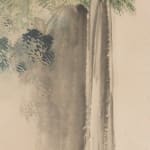





Shiokawa Bunrin (1808 - 1877)
Waterfall, ca. 1850
Sumi Ink and Color on Paper
49” X 17 3/4” ; scroll, 75 1/2” X 23 1/2”
Further images
Using negative space, Shiokawa depicts the thunderous flow of water cascading down the rock formation. It is as if the plants surrounding the waterfall are also moving with the splashing...
Using negative space, Shiokawa depicts the thunderous flow of water cascading down the rock formation. It is as if the plants surrounding the waterfall are also moving with the splashing water.
The vantage point presented by the artist suggests that we are looking at it head-on. Shiokawa guides our eyes to the upper half of the waterfall leaving its bottom hidden from view, emphasizing its scale and power. Its grand and commanding presence also exudes a roaring tranquility.
About the Artist:
Shiokawa Bunrin was born in Kyoto in 1808, as a son of a samurai. At age 14, upon his father's passing, he moved to live with relatives in Fushimi in Kyoto. Little is known of his early career until the1850s when he appeared as an established artist working in the Imperial Palace. During the chaotic years before the Meiji restoration, Bunrin stayed away from the center of Kyoto and spent time studying collections of many temples and shrines of the region. He also encountered with western paintings at this period. He was a major artist, who greatly influenced the Kyoto style of painting in the early Meiji era.
The vantage point presented by the artist suggests that we are looking at it head-on. Shiokawa guides our eyes to the upper half of the waterfall leaving its bottom hidden from view, emphasizing its scale and power. Its grand and commanding presence also exudes a roaring tranquility.
About the Artist:
Shiokawa Bunrin was born in Kyoto in 1808, as a son of a samurai. At age 14, upon his father's passing, he moved to live with relatives in Fushimi in Kyoto. Little is known of his early career until the1850s when he appeared as an established artist working in the Imperial Palace. During the chaotic years before the Meiji restoration, Bunrin stayed away from the center of Kyoto and spent time studying collections of many temples and shrines of the region. He also encountered with western paintings at this period. He was a major artist, who greatly influenced the Kyoto style of painting in the early Meiji era.
Signup for our Newsletter
You will receive two emails a month from us. One introduces artworks and design works from Kyoto's hidden sources and the other is stories from Misako, sharing insights into Japanese culture.
* denotes required fields
为了回应您的查询,我们将根据我们的隐私政策处理您提供的个人数据。





